Perception Evaluation and Optimization Strategies of Pedestrian Space in Beijing Fayuan Temple Historic and Cultural District
Abstract
1. Introduction
1.1. Research Background
1.2. Research Significance and Problems
1.3. Literature Review
2. Materials and Methods
2.1. Research Objects
2.2. Data Collection
2.2.1. Collection of Online Text Data
2.2.2. Data Collection from Field Research
2.3. Analysis Method
2.3.1. LDA Topic Modeling
2.3.2. Social Network Semantic Analysis
2.3.3. Importance–Satisfaction (IPA) Analysis Method
3. Results
3.1. Screening of Perceptual Elements
3.2. Construction of the Perception Dimension System
3.2.1. Analysis of Perception on Material Elements
3.2.2. Analysis of Perception of Intangible Elements
3.3. Results of IPA Analysis
3.3.1. Distribution Characteristics and Analysis of Perceptual Elements
3.3.2. Existing Core Issues of Elements
- (1)
- Temporal–Spatial Mismatch between Block Texture Protection and Functional Activation
- (2)
- Dynamic Imbalance between Transportation System Transformation and Tourist Demand
- (3)
- Insufficient Narration in Landscape Environment Creation and Historical Context
- (1)
- The plight of superficialization in the transmission of cultural memory
- (2)
- The crisis of spectacularization in community interaction networks
- (3)
- The dilemma of symbolization in the construction of emotional identity
4. Discussion
4.1. Main Research Summary
4.1.1. Main Research Conclusions
4.1.2. Reflection and Summary
4.1.3. Similarities and Differences and Theoretical Extension
4.2. Pedestrian Space Optimization Strategy
4.2.1. Protection of Neighborhood Spatial Form and Layout
4.2.2. Composite Functions and Usage Optimization of Transportation
4.2.3. Symbiosis Between Landscape Ecology and Narrative Experience
4.2.4. Constructing “Time-Space Narrative—Digital Activation”
4.2.5. Translating the Symbol System of “Cultural Genes”
4.3. Theoretical Implications Based on the Global Framework
5. Conclusions
5.1. Research Content and Limitations
- (1)
- Constraints on the timeliness of data
- (2)
- Lack of segmentation of tourist types
- (3)
- Limitations of spatial scale and theoretical framework
5.2. Future Outlook
Author Contributions
Funding
Institutional Review Board Statement
Informed Consent Statement
Data Availability Statement
Conflicts of Interest
References
- The General Office of the Communist Party of China Central Committee and the General Office of the State Council issued the “Cultural Development Plan for the 14th Five—Year Plan Period”. Available online: https://www.gov.cn/zhengce/2022-08/16/content_5705612.htm (accessed on 8 August 2022).
- Design Guidelines for the Conservation and Renewal of Historical and Cultural Blocks in Beijing. Available online: https://ghzrzyw.beijing.gov.cn/biaozhunguanli/bzxg/201912/P020191213652324033184.pdf (accessed on 13 December 2019).
- Solid Progress in New-Type Urbanization and Steady Improvement in Urban Development Quality—Series Report on Economic and Social Development Achievements Since the 18th National Congress of the Communist Party of China: No. 12. Available online: https://www.stats.gov.cn/xxgk/jd/sjjd2020/202209/t20220929_1888803.html (accessed on 29 September 2022).
- Statistical Communiqué on Cultural and Tourism Development 2023 by the Ministry of Culture and Tourism of the People’s Republic of China. Available online: https://zwgk.mct.gov.cn/zfxxgkml/tjxx/202408/t20240830_954981.html (accessed on 30 August 2024).
- Tan, Z.N.; Tang, B.; Yi, S.Y.; Wang, Z.G. Planning and Design of Hezhou Garden Expo Park from the Perspective of Contextual Continuity. Jiangsu Agric. Sci. 2021, 49, 124–131. (In Chinese) [Google Scholar] [CrossRef]
- Song, Y.Y. The Role of Tourism in Urban Renewal from the Perspective of Cultural and Tourism Integration. Tour. Trib. 2024, 39, 8–10. (In Chinese) [Google Scholar] [CrossRef]
- Detailed Regulatory Plan for the Core Functional Area of the Capital (at the Block Level) (2018–2035). Available online: https://www.beijing.gov.cn/zhengce/zhengcefagui/202008/t20200828_1992592.html (accessed on 2 August 2020).
- Choi, S.; Walter, R.J.; Chalana, M.J.C. Untangling our checkered past: Investigating the link between local historic district designation and spatial segregation history. Cities 2025, 158, 105621. [Google Scholar] [CrossRef]
- Li, R.; Li, C.X.; Rui, G.Y. Study on the Formulation Method of Conservation Planning for Historical and Cultural Blocks from the Perspective of Historic Urban Landscape (HUL)—A Case Study of Fengyuan Street-Liwan Lake Historical and Cultural Block in Guangzhou. Planners 2020, 36, 66–72+85. (In Chinese) [Google Scholar]
- Wang, J.G. Exploration on Adaptive Conservation, Renovation and Vitality Regeneration Paths of Historical and Cultural Blocks—A Case Study of Gunan Street in Dingshu, Yixing. Archit. J. 2021, 05, 1–7. (In Chinese) [Google Scholar] [CrossRef]
- Jiang, X.; Zhang, X.; Qian, X.J.; Lin, Q.; Wang, X.R. Study on “Authenticity” Perception Evaluation and Renewal Strategies of Canal Historical and Cultural Blocks (Famous Towns) Based on Multi-Source Data. Mod. Urban Res. 2021, 7, 20–27+37. (In Chinese) [Google Scholar]
- Song, Z.H.; Tang, P.; Wang, X.; Song, Y.C. Construction and Application of a Multi-Scale Hierarchical Structure Analysis Model for Historic Districts—A Case Study of Hehuatang Historical and Cultural Block in Nanjing. Archit. J. 2023, 10, 55–61. (In Chinese) [Google Scholar] [CrossRef]
- Wu, Y.; Chi, F.A. “Conservation and Renewal of Historical and Cultural Blocks: Theoretical Exploration and Huzhou Practice”: Summary of Theories and Practical Application in Conservation of Historical and Cultural Blocks. Archit. J. 2024, 03, 127. (In Chinese) [Google Scholar]
- Zhang, L.Z. Study on Optimization of Walking Environment in Living Streets Based on Landscape Preference Analysis. Master’s Thesis, Tianjin University, Tianjin, China, 2021. (In Chinese). [Google Scholar]
- Zhou, X.; Wang, Z. PEST Analysis of Historical and Cultural Block Research and Suggestions on Renewal Strategies. China Anc. City 2024, 38, 67–73. (In Chinese) [Google Scholar] [CrossRef]
- Li, Y. The Reference of Paris’ Historical Style Conservation for Beijing’s Urban Construction. Master’s Thesis, University of International Business and Economics, Beijing, China, 2005. (In Chinese). [Google Scholar]
- Zhang, B. Study on the Internal Mechanism and Methods of Urban Design Control Based on Digital Platforms. Ph.D. Thesis, Southeast University, Nanjing, China, 2021. (In Chinese) [Google Scholar] [CrossRef]
- He, K.; Qi, K.; Wang, C.K. Insights from Japan’s Arcade Shopping Streets for the Renovation of Traditional Blocks in China. Mod. Urban Res. 2011, 26, 49–53. (In Chinese) [Google Scholar]
- Carmona, M. Re-theorising contemporary public space: A new narrative and a new normative. J. Urban. Int. Res. Placemaking Urban Sustain. 2015, 8, 373–405. [Google Scholar] [CrossRef]
- Scoppa, M.; Bawazir, K.; Alawadi, K. Walking the superblocks: Street layout efficiency and the sikkak system in Abu Dhabi. Sustain. Cities Soc. 2018, 38, 359–369. [Google Scholar] [CrossRef]
- Aceves-González, C.; Ekambaram, K.; Rey-Galindo, J.; Rizo-Corona, L. The role of perceived pedestrian safety on designing safer built environments. Traffic Inj. Prev. 2020, 21, S84–S89. [Google Scholar] [CrossRef] [PubMed]
- Hashemi Juzdani, M.; Morgan, C.H.; Schwebel, D.C.; Tabibi, Z. Children’s Road-Crossing Behavior: Emotional Decision Making and Emotion-Based Temperamental Fear and Anger. J. Pediatr. Psychol. 2020, 45, 1188–1198. [Google Scholar] [CrossRef]
- Ferenchak, N.N.; Marshall, W.E. Quantifying suppressed child pedestrian and bicycle trips. Travel Behav. Soc. 2020, 20, 91–103. [Google Scholar] [CrossRef]
- Jiang, Q.; Yu, L.; Ziran, D.; Shun, S. Behavior pattern mining based on spatiotemporal trajectory multidimensional information fusion. Chin. J. Aeronaut. 2023, 36, 387–399. [Google Scholar] [CrossRef]
- Bhat, M.R.; Kundroo, M.A.; Tarray, T.A.; Agarwal, B. Deep LDA: A new way to topic model. J. Inf. Optim. Sci. 2020, 41, 823–834. [Google Scholar] [CrossRef]
- Arroyo-Machado, W.; Torres-Salinas, D.; Robinson-Garcia, N. Identifying and characterizing social media communities: A socio-semantic network approach to altmetrics. Scientometrics 2021, 126, s11192-s021. [Google Scholar] [CrossRef]
- Mimbs, B.P.; Boley, B.B.; Bowker, J.; Woosnam, K.M.; Green, G.T. Tourism. Importance-performance analysis of residents’ and tourists’ preferences for water-based recreation in the Southeastern United States. J. Outdoor Recreat. Tour. 2020, 31, 100324. [Google Scholar] [CrossRef]
- Xiong, A.N. Study on Evaluation and Optimization of Landscape Image of Famous Historical and Cultural Towns from the Perspective of Tourist Perception. Master’s Thesis, Southwest University, Chongqing, China, 2023. (In Chinese). [Google Scholar]
- Li, J.; Gao, J.; Zhang, Z.H.; Fu, J.; Shao, G.F.; Zhao, Z.Y.; Yang, P.P. Insights into citizens’ experiences of cultural ecosystem services in urban green spaces based on social media analytics. Landsc. Urban Plan. 2024, 244, 104999. [Google Scholar] [CrossRef]
- Zhang, D.; Chen, H.; Zhang, X.; Tan, L. Evaluation of Landscapes and Soundscapes in Traditional Villages in the Hakka Region of Guangdong Province Based on Audio-Visual Interactions. Buildings 2025, 15, 259. [Google Scholar] [CrossRef]
- Xie, Q.; Hu, L.; Wu, J.; Shan, Q.; Li, W.; Shen, K. Investigating the Influencing Factors of the Perception Experience of Historical Commercial Streets: A Case Study of Guangzhou’s Beijing Road Pedestrian Street. Buildings 2024, 14, 138. [Google Scholar] [CrossRef]
- Frączkiewicz-Wronka, A.; Wronka-Pośpiech, M. How Practices of Managing Partnerships Contributes to the Value Creation—Public–Social Partnership Perspective. Sustainability 2018, 10, 4816. [Google Scholar] [CrossRef]
- Zhang, Q.; Lu, L.; Huang, J.; Zhang, X. Uneven development and tourism gentrification in the metropolitan fringe: A case study of Wuzhen Xizha in Zhejiang Province, China. Cities 2022, 121, 103476. [Google Scholar] [CrossRef]
- Yang, S.H. Research on Tourist Demand Identification Method Based on LDA and Kano-IPA Model. Master’s Thesis, Jilin University, Jilin, China, 2024. (In Chinese). [Google Scholar]
- Liu, L.X. Discussion on the Physical and Functional Protection of Historical Districts: A Case Study of the Renovation of Chengdu’s Kuanzhai Alle. Intell. Build. Smart City 2020, 07, 123–124+131. [Google Scholar] [CrossRef]
- Lin, Z.R.; Chen, K.Y.; Jiao, K.; Li, Z.X. Spatio-temporal characteristics of traditional village landscape pattern and its influencing factors from the perspective of tourism development: A case study of Huangcheng Village, China. J. Asian Archit. Build. Eng. 2025, 24, 1000–1012. [Google Scholar] [CrossRef]
- Zhu, J.C.; Liu, R.Q. Research on the working methods of responsible planners in Beijing’s historical and cultural districts—taking the Xuanan historical and cultural district in Beijing as an example. Urban Archit. Space 2024, 4, 71–73. (In Chinese) [Google Scholar]
- Wang, D.; Li, S. Social conflicts and their resolution paths in the commercialized renewal of old urban communities in China under the perspective of public value. J. Urban Manag. 2025, 14, 402–417. [Google Scholar] [CrossRef]
- Sang, X.L.; Huang, C.H.; Wei, H.B. Recreating historical contexts: Methods and strategies for the restoration of the ‘spatio-temporal landscape’ of Ao Garden in Xiamen, Fujian Province, China. J. Asian Archit. Build. Eng. 2024, 24, 4103–4118. [Google Scholar] [CrossRef]
- Wang, T.H.; Zhang, R.C. From static to dynamic: The protection of vernacular architectural heritage from the perspective of eco-museums. Archit. Cult. 2020, 10, 205–207. (In Chinese) [Google Scholar] [CrossRef]
- The Regulations on the Protection of Beijing as a Famous Historical and Cultural City. Available online: https://wwj.beijing.gov.cn/bjww/wwjzzcslm/1737418/1738081/xyzx/10936392/index.html (accessed on 2 February 2021).
- Ghanbari, E.; Lotfi, S.; Sholeh, M. HUL values in practice: A character area designation model for the conservation of built heritage in less-developed regions. J. Cult. Herit. 2024, 70, 41–53. [Google Scholar] [CrossRef]
- Dong, J.W.; Wang, Y.H.; Wang, L.L.; Zhao, W.J.; Huang, C. Assessment of PM2. 5 exposure risk towards SDG indicator 11. 6. 2-A case study in Beijing. Sustain. Cities Soc. 2022, 82, 103864. [Google Scholar] [CrossRef]
- Ding, C.; Chen, X.; Wang, Z.Y. Spatial morphology of canal residences from the perspective of cultural ecology: Insights from the Yaowan Ancient Town in northern Jiangsu province, China. J. Asian Archit. Build. Eng. 2025, 1–25. [Google Scholar] [CrossRef]
- Wang, X.; Wang, Q. New Interpretation of Old Streets: The Organic Renewal Practice of Traditional Commercial Blocks in Old Cities in the Context of Cultural Weaving. In Proceedings of the 4th International Conference on Architecture: Heritage, Traditions and Innovations (AHTI 2022), Online, 24–25 February 2022; pp. 209–217. [Google Scholar] [CrossRef]
- Liu, S.; Zhang, L.Z.; Zhao, Y.T. Research on Sustainable Renewal Governance of Old Urban Blocks and Their Supporting Policies. Urban Insight 2024, 89, 111–125. (In Chinese) [Google Scholar] [CrossRef]
- Zolfi Gol, S.; Sajadzadeh, H. A study of spatial syntax of traditional neighborhood structure with catalyst approach, case study: Haji Neighborhood in Hamedan. Geogr. Environ. Plan. 2018, 28, 53–70. [Google Scholar] [CrossRef]
- Daly, P.; Dias, A.L.; Patuleia, M. The impacts of tourism on cultural identity on Lisbon historic Neighbourhoods. J. Ethn. Cult. Stud. 2021, 8, 1–25. [Google Scholar] [CrossRef]
- Sun, C.; Zhou, Y.; Han, Y.J.B. Automatic generation of architecture facade for historical urban renovation using generative adversarial network. Build. Environ. 2022, 212, 108781. [Google Scholar] [CrossRef]
- Dwivedi, Y.K.; Kshetri, N.; Hughes, L.; Slade, E.L.; Jeyaraj, A.; Kar, A.K.; Baabdullah, A.M.; Koohang, A.; Raghavan, V.; Ahuja, M.; et al. Opinion Paper: “So what if ChatGPT wrote it?” Multidisciplinary perspectives on opportunities, challenges and implications of generative conversational AI for research, practice and policy. Int. J. Inf. Manag. 2023, 71, 102642. [Google Scholar] [CrossRef]
- Mamvura, Z. Reconstituting the cultural geography in Zimbabwe: Place renaming in Zimbabwe’s ‘new dispensation’. Geopolitics 2022, 27, 972–994. [Google Scholar] [CrossRef]
- De Fina, A. Doing narrative analysis from a narratives-as-practices perspective. Narrat. Inq. 2021, 31, 49–71. [Google Scholar] [CrossRef]


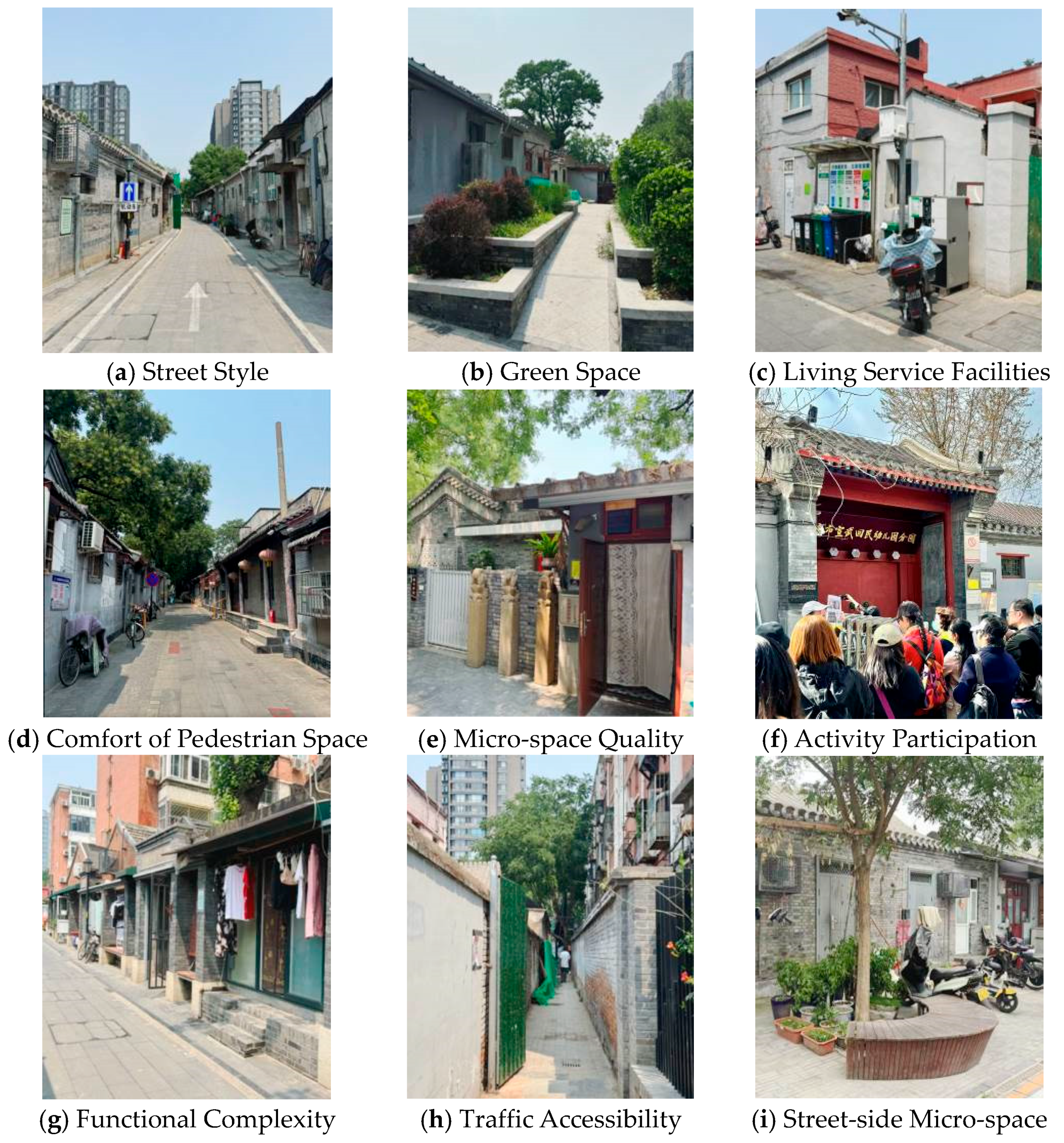

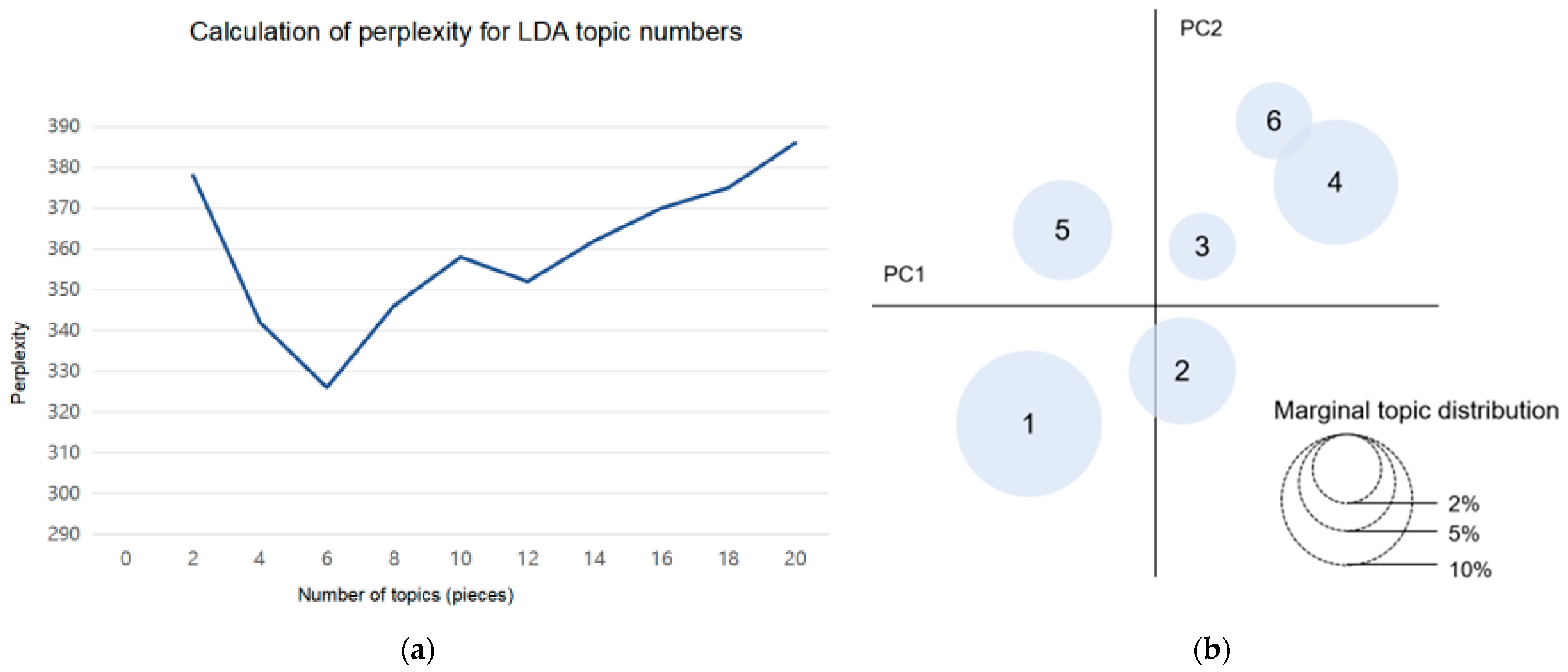
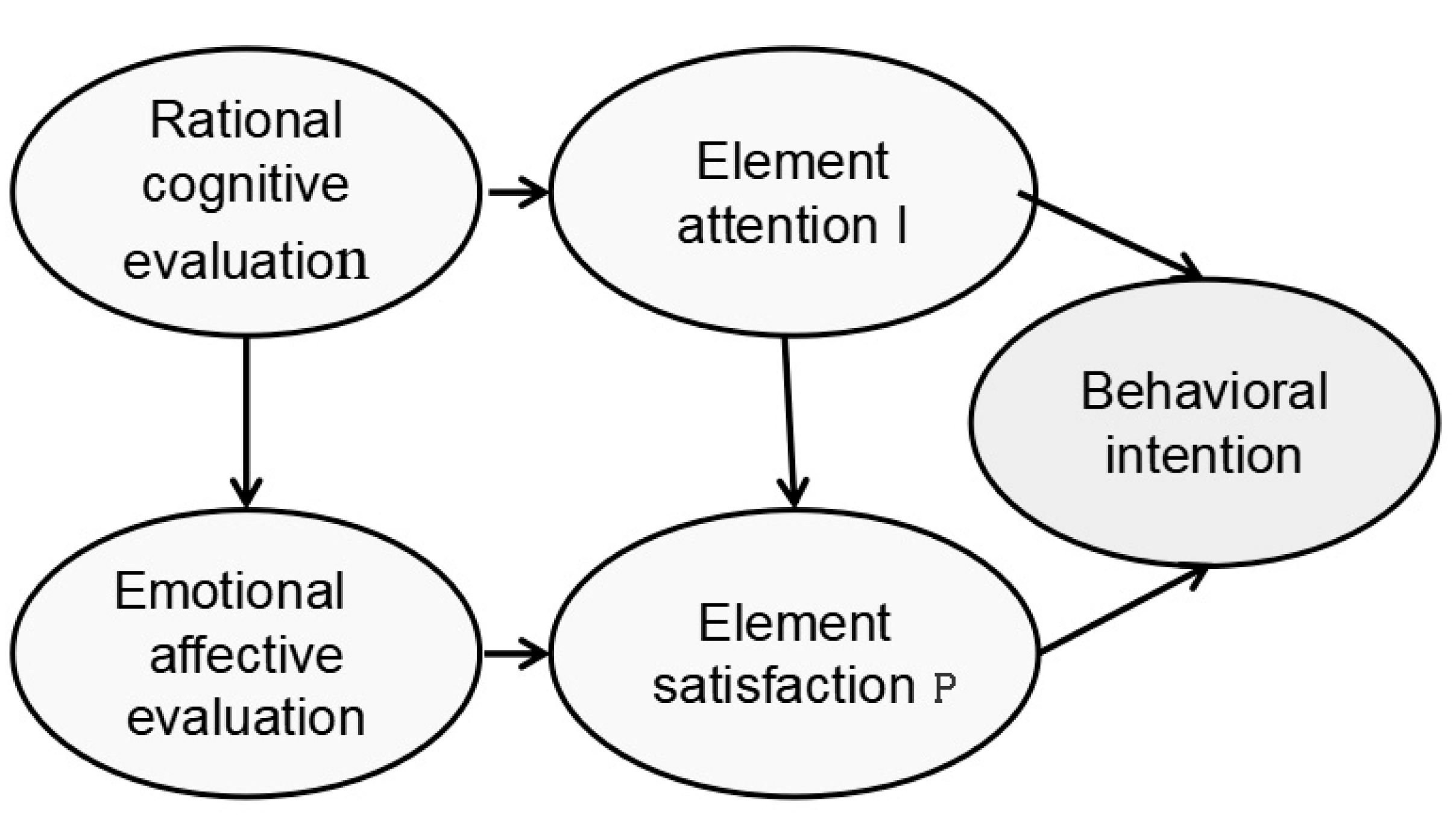
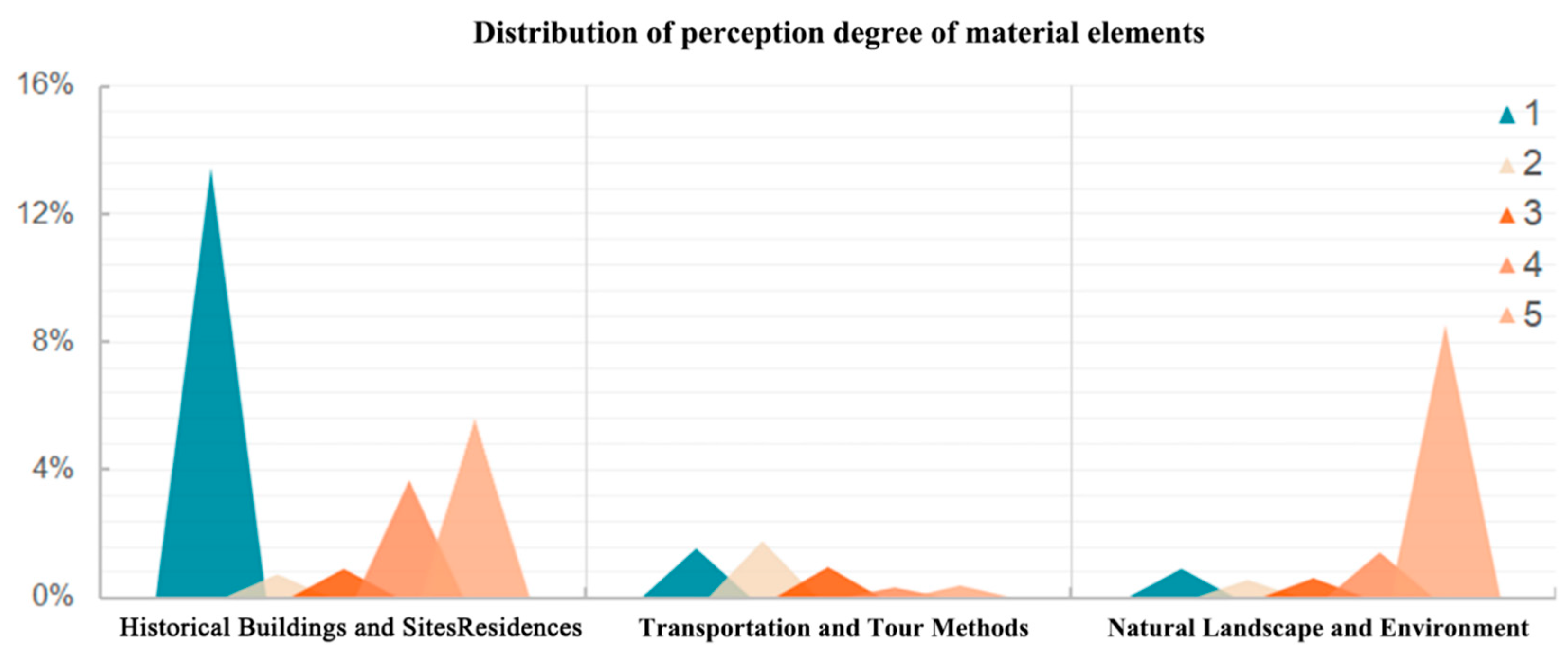
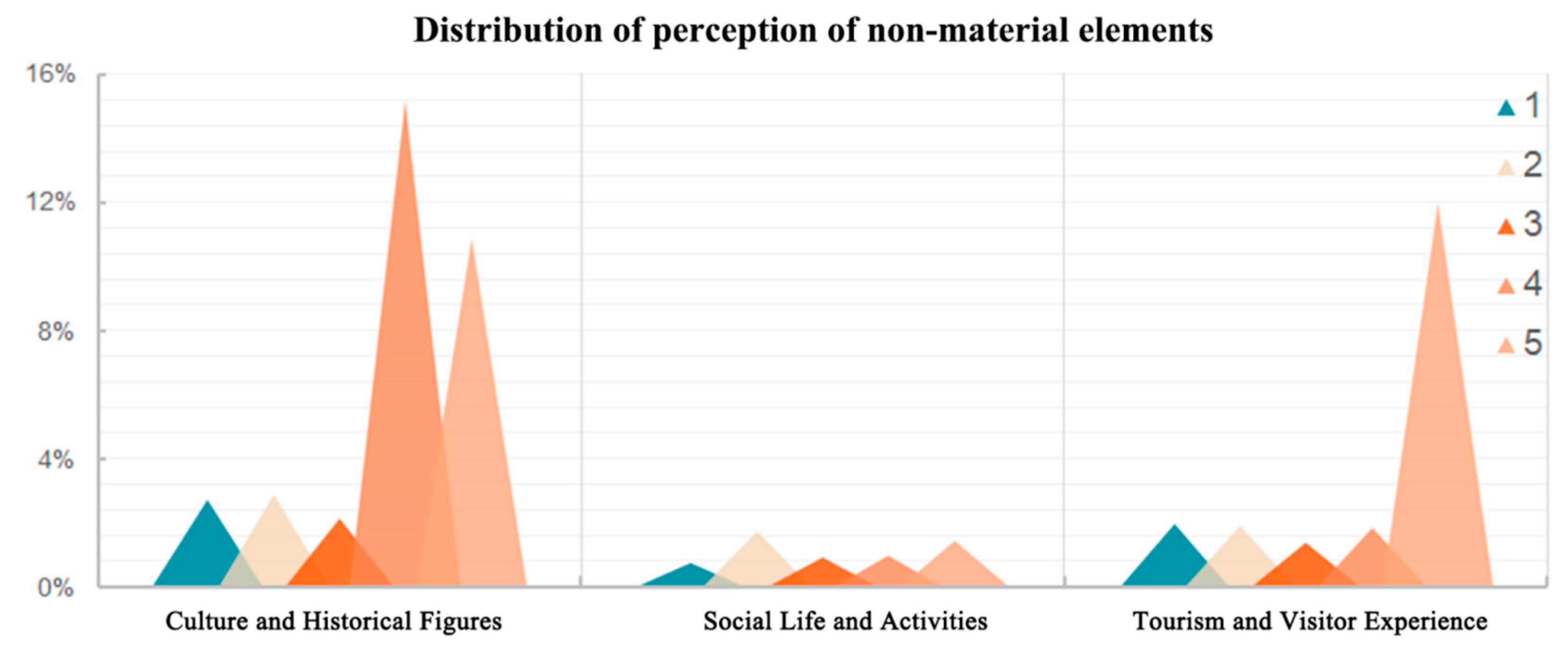
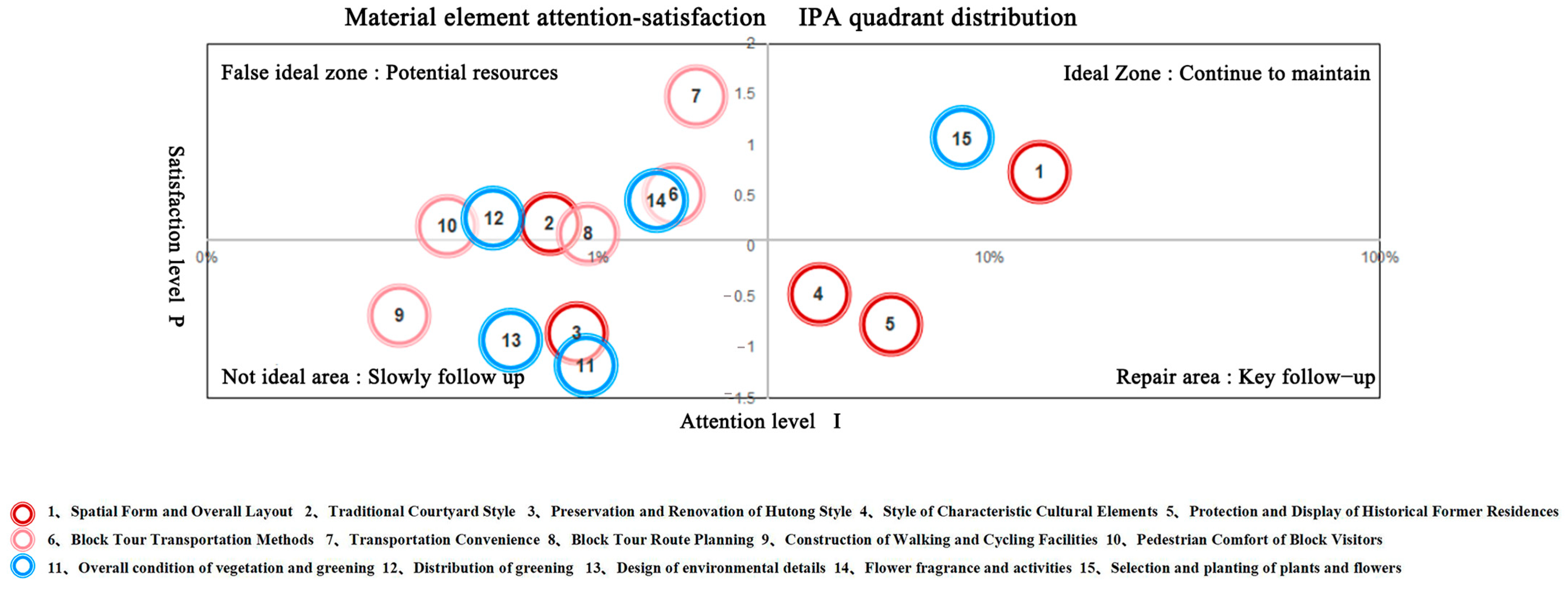


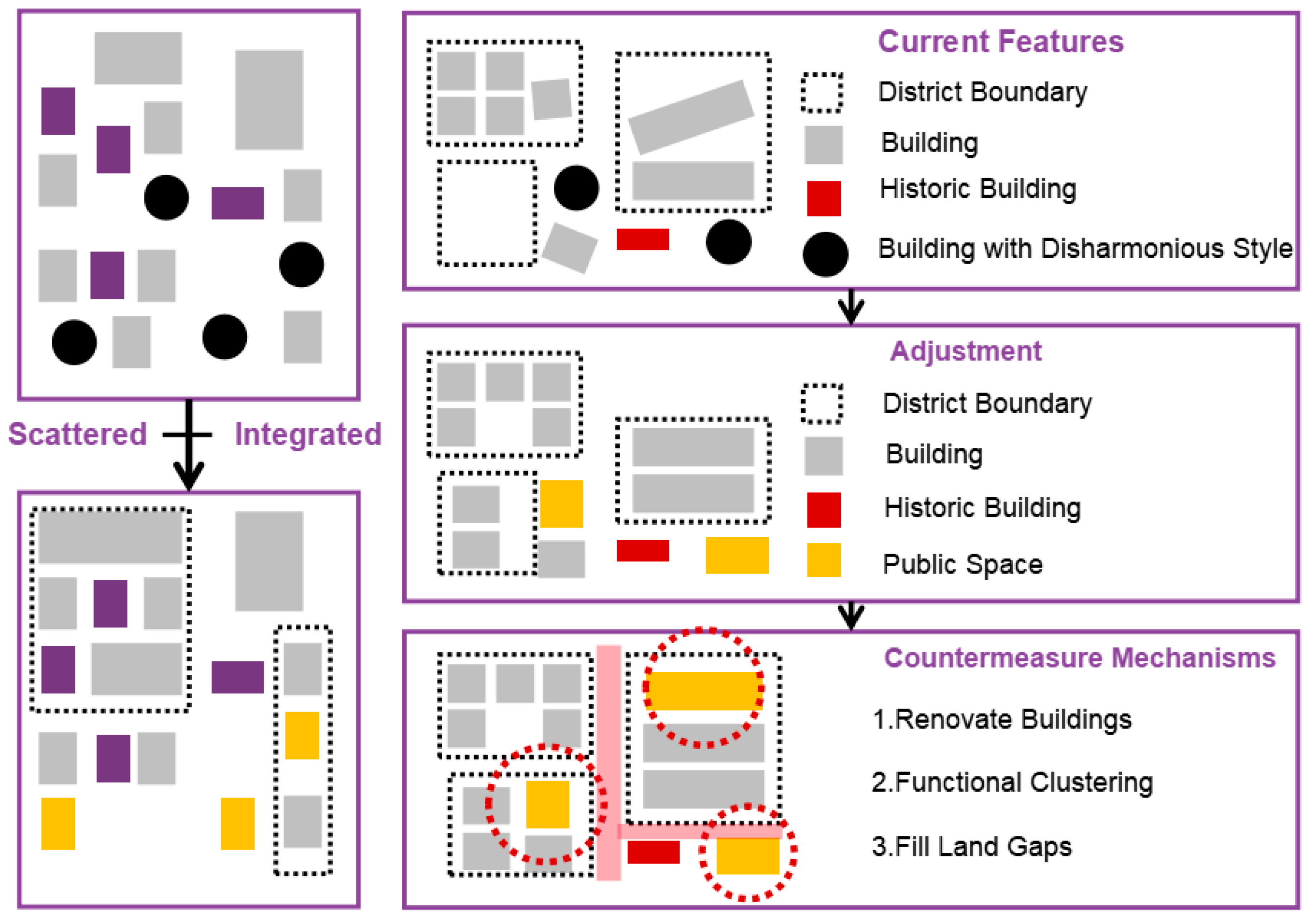



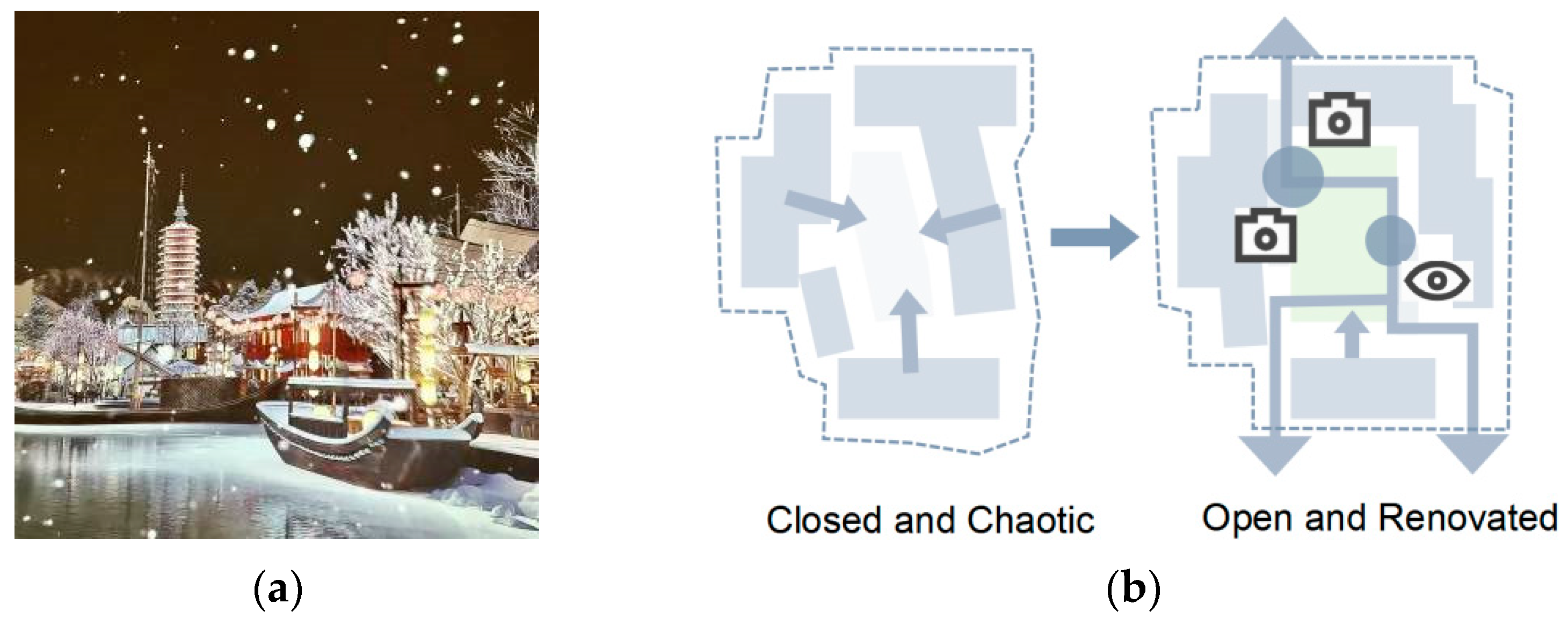
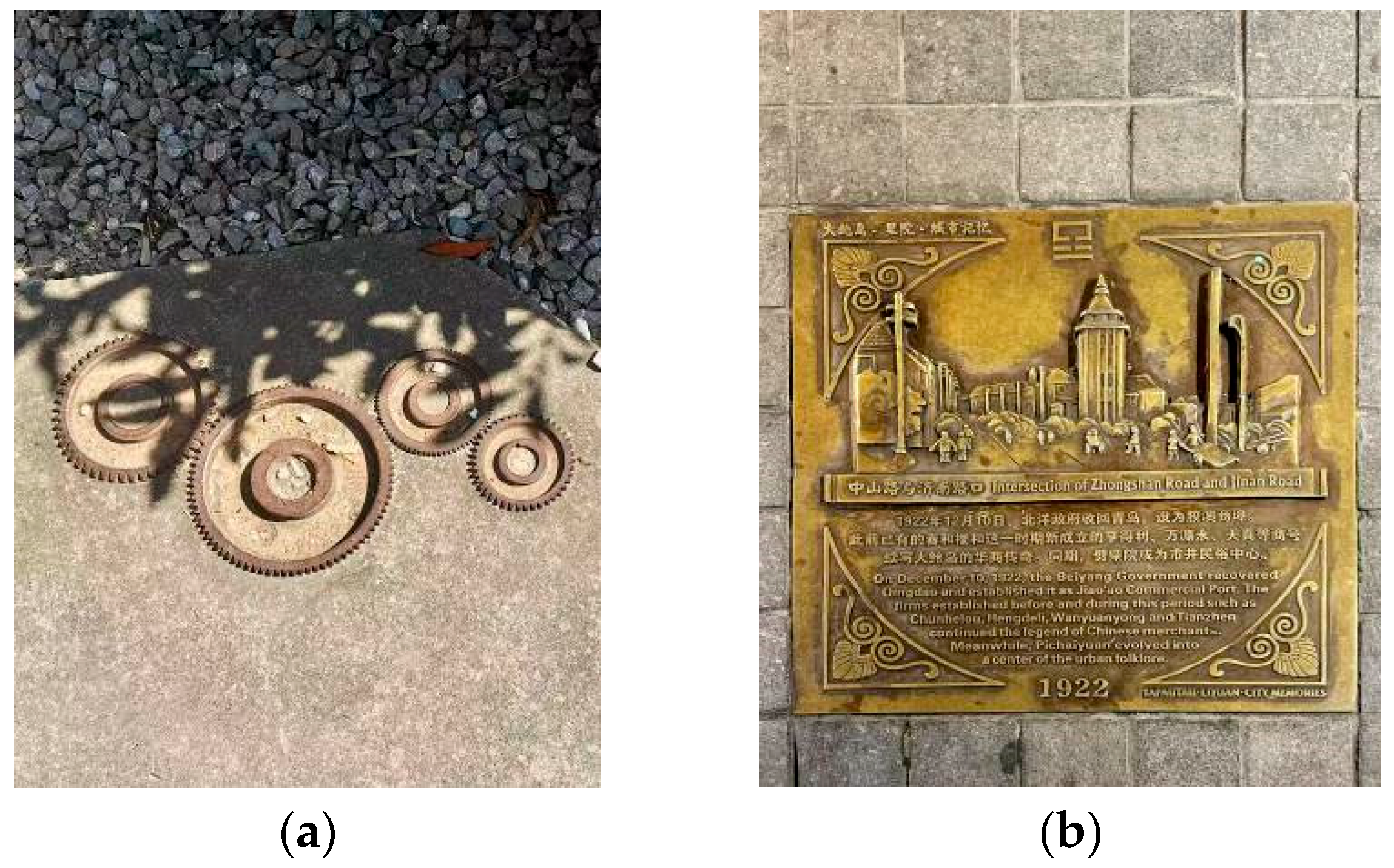
| Research Dimension | Core Content and Representative Achievements |
|---|---|
| Evolution of conservation theories | A shift from the protection of individual buildings to the holistic conservation of districts; theories such as “organic renewal” and “micro-renovation” have been proposed, emphasizing the continuation of historical textures and the preservation of cultural authenticity |
| Spatial activation strategies | Enhancing district vitality through the optimization of pedestrian systems and mixed-use layouts; establishing the IPA (Importance–Performance Analysis) model to evaluate environmental satisfaction |
| Social participation mechanisms | Developing a multi-stakeholder governance model involving governments, residents, and enterprises; the experience of Japanese “community building” shows a positive correlation between residents’ participation and the effectiveness of renewal |
| Technological application innovations | Utilizing GIS and digital twin technologies to simulate pedestrian flow and spatial usage; the case of Sheffield, UK, demonstrates that data-driven design can enhance walking comfort |
| Culture–economy balance | Conducting critical research on the “gentrification” effect and advocating the restriction of excessive commercialization; Lisbon, Portugal, has achieved a win-win situation for cultural value and economic benefits through the activation of intangible cultural heritage |
| Sustainable renewal models | Sustainable renewal models: Promoting low-carbon materials and green infrastructure; the “ecological district” project in Freiburg, Germany, integrates historical conservation with energy recycling systems |
| Serial Number | Classification of Similar Factors | Related Perceptual Factors | Dimensions of Perceptual Factors |
|---|---|---|---|
| 1 | Spatial Form and Layout | Interface form, form design, spatial layout, street interface, spatial details, road cross-section, cross-sectional structure, open space, node space, node landscape space, micro-space capacity, guiding design of spatial interface elements, comfortable and pleasant spatial scale, spatial interface, pedestrian space scale, original spatial texture | Material Elements |
| 2 | Environmental Landscape and Greening | Landscape environment, green space, multi-level plant configuration, green view ratio, road greening (green view ratio), green landscape, landscape configuration, furniture landscape, street paving, public facilities, rational planning of road traffic systems, historic district features, spatial order of historic districts | |
| 3 | Composite Functions and Usage | Safe and unobstructed pedestrian traffic network, parking lots, living service facilities, no-parking measures, residents’ activity spaces, richness of outdoor activities, public facilities, memory places, adjustment of pedestrian system structure, vitality of micro-spaces, integration of architectural spaces and micro-spaces, spatial order of historic districts | |
| 4 | Innovative Design and Optimization | Characteristic optimized facilities, refined design, creation of positive spaces, introduction of innovative technologies, organic renewal (cultural buildings), optimization of traffic flow in micro-spaces, district spatial quality, spatial details, integration of pedestrian interfaces, building itself | |
| 5 | Cultural Inheritance and Construction | Regional culture, inheritance and promotion of historical culture, construction of place culture, perceived space | Immaterial Elements |
| 6 | Spatial Quality and Experience | Spatial comfort, spatial aesthetics, overall experience, pedestrian space quality, openness, sharing and pleasantness, comfort of walking activities, scale, tourists’ needs | |
| 7 | Usage Functions and Services | Public service facilities, commerce and services, convenience of use, service satisfaction, functional complexity, sharing, connection with destinations | |
| 8 | Traffic Accessibility and Connection | Traffic connections, internal traffic organization, guidance and direction, pedestrian environment, coordination of multiple transportation modes, accessibility and friendliness, connection with public spaces (connectivity, accessibility) |
| Research Object | Related Issues | Purpose of Setting |
|---|---|---|
| Interviewee | Gender | Understand the impact of tourists’ social characteristics on the satisfaction evaluation of perceived factors |
| Age | ||
| Occupation | ||
| Educational Qualification | ||
| Place of Residence | ||
| Number of visits to Fayuan Temple district | ||
| Perceptual factors of pedestrian spaces | Material factors | Understand the overall satisfaction evaluation of pedestrian spaces |
| Intangible elements | ||
| Types of perceptual elements | Historical Buildings and Sites | Understand the overall satisfaction evaluation of pedestrian spaces |
| Transportation and Tour Methods | ||
| Natural Landscape and Environment | ||
| Culture and Historical Figures | ||
| Social Life and Activities | ||
| Tourism and Visitor Experience |
| Perception Dimension | Perception Theme | Induction of Perception Elements | Perception Factors | Total Perception Degree | Proportion of Total Perception Degree |
|---|---|---|---|---|---|
| Material Elements | Historical Buildings and Sites | (1) Spatial Form and Overall Layout | Hutong 6620, Street 171 | 6791 | 13.45% |
| (2) Traditional Courtyard Style | Courtyard 377 | 377 | 0.75% | ||
| (3) Preservation and Renovation of Hutong Style | Renovation 163, Street-lane 281 | 444 | 0.88% | ||
| (4) Style of Characteristic Cultural Elements | Temple 663, Building 512, Former Residence 676 | 1851 | 3.66% | ||
| (5) Protection and Display of Historical Former Residences | Hunan Guild Hall 316, Liuyang Guild Hall 387, Shaoxing Guild Hall 2114 | 2817 | 5.58% | ||
| Transportation and Tour Methods | (1) Block Tour Transportation Methods | Cycling 276, Walking 512 | 788 | 1.56% | |
| (2) Transportation Convenience | Xicheng District 448, Subway station 450 | 898 | 1.78% | ||
| (3) Block Tour Route Planning | Route 256, Visit 218 | 474 | 0.94% | ||
| (4) Construction of Walking and Cycling Facilities | Path 159 | 159 | 0.31% | ||
| (5) Pedestrian Comfort of Block Visitors | Strolling 209 | 209 | 0.41% | ||
| Natural Landscape and Environment | (1) Overall Vegetation and Greening Condition | Green plants 241, Environment 229 | 470 | 0.93% | |
| (2) Distribution of greening | Shade 274 | 274 | 0.54% | ||
| (3) Design of environmental details | Details 153, Tranquility 152 | 305 | 0.60% | ||
| (4) Flower fragrance and activities | Flower fragrance 191, Blooming 319, Flower events 200 | 710 | 1.41% | ||
| (5) Selection and Planting of Plants and Flowers | Begonia 233, Lilac 4065 | 4298 | 8.51% | ||
| Immaterial Elements | Culture and Historical Figures | (1) Protection of Cultural Heritage | History 994, Antiquity 375 | 1369 | 2.71% |
| (2) Display and Inheritance of Cultural Heritage | Temple 1126, Cultural relics 320 | 1446 | 2.86% | ||
| (3) Immersive Cultural Experience Activities | Story 207, Drama 273, Poetry meeting 605 | 1085 | 2.15% | ||
| (4) Display of the Historical Background and Cultural Atmosphere of Fayuan Temple | Fayuan Temple 6778, Buddhism 346, Ancient temple 537 | 7661 | 15.17% | ||
| (5) Cultural Protection and Display of Guild Halls and Celebrities’ Former Residences | Guild Hall 3265, Lu Xun 1256, Tan Sitong 718, Diary of a Madman 266 | 5505 | 10.90% | ||
| Social Life and Activities | (1) Distribution and Experience of Rest Facilities | Coffee 197, Coffee shop 160 | 357 | 0.71% | |
| (2) Attractiveness for Photography | Taking photos 326, Pigeon 165, Wisteria 389 | 880 | 1.74% | ||
| (3) Experience of life atmosphere in old town blocks | Life 303, Atmosphere 157 | 460 | 0.91% | ||
| (4) Experience of Community Activities | Activity 340, Resident 159 | 499 | 0.99% | ||
| (5) Quality of Residents’ Living Environment | Xicheng 256, Residence 290, Nancheng 177 | 723 | 1.43% | ||
| Tourism and Visitor Experience | (1) Overall Sensory Experience of Visiting the Block | Feeling 518, Quiet 292, Serene 168 | 978 | 1.94% | |
| (2) Overall Psychological Experience and Identification with Visiting the Block | Like 293, Romantic 191, Check-in 482 | 966 | 1.91% | ||
| (3) Experience of Historical and Cultural | Feeling 378, Photo 150, Internet-famous 181 | 709 | 1.40% | ||
| (4) Sense of acquisition of historical culture | Time-honored 195, Lin Huiyin 151, Visit 393, Chinese history 200 | 939 | 1.86% | ||
| (5) Obtaining in-depth feelings of Old Beijing culture | Beijing 5336, Culture 416, Tourist 313 | 6065 | 12.01% |
| Quadrant | Perceptual Element | Perceptual Theme | Satisfaction P1 | Perception Degree I1 |
|---|---|---|---|---|
| First Quadrant (Ideal Zone) | Spatial Form and Overall Layout | Historical Buildings and Sites | 0.74 | 13.45% |
| Selection and Planting of Plants and Flowers | Natural Landscape and Environment | 1.07 | 8.51% | |
| Second Quadrant (False Ideal Zone) | Style of Characteristic Cultural Elements | Historical Buildings and Sites | −0.47 | 3.66% |
| Protection and Display of Historical Former Residences | −0.76 | 5.58% | ||
| Third Quadrant (Unideal Zone) | Preservation and Renovation of Hutong Style | Historical Buildings and Sites | −0.85 | 0.88% |
| Atmosphere and Characteristics of Ancient Buildings | −1.29 | 2.08% | ||
| Construction of Walking and Cycling Facilities | Transportation and Tour Methods | −0.68 | 0.31% | |
| Overall Vegetation and Greening Condition | Natural Landscape and Environment | −1.17 | 0.93% | |
| Design of environmental details | −0.92 | 0.60% | ||
| Fourth Quadrant (Repair Zone) | Traditional Courtyard Style | Historical Buildings and Sites | 0.23 | 0.75% |
| Block Tour Transportation Methods | Transportation and Tour Methods | 0.52 | 1.56% | |
| Transportation Convenience | 1.49 | 1.78% | ||
| Block Tour Route Planning | 0.13 | 0.94% | ||
| Pedestrian Comfort of Block Visitors | 0.21 | 0.41% | ||
| Distribution of greening | Natural Landscape and Environment | 0.28 | 0.54% | |
| Flower fragrance and activities | 0.45 | 1.41% | ||
| Average Perception of Material Elements | −0.064 | 2.65% | ||
| Quadrant | Perceptual Element | Perceptual Theme | Satisfaction P2 | Perception Degree I2 |
|---|---|---|---|---|
| First Quadrant (Ideal Zone) | Display of the Historical Background and Cultural Atmosphere of Fayuan Temple | Culture and Historical Figures | 1.36 | 15.17% |
| Second Quadrant (False Ideal Zone) | Protection of Cultural Heritage | −0.54 | 2.71% | |
| Display and Inheritance of Cultural Heritage | −1.46 | 2.86% | ||
| Cultural Protection and Display of Guild Halls and Celebrities’ Former Residences | −1.61 | 10.90% | ||
| Third Quadrant (Unideal Zone) | Immersive Cultural Experience Activities | Culture and Historical Figures | −1.07 | 2.15% |
| Quality of Residents’ Living Environment | Social Life and Activities | −0.33 | 1.43% | |
| Sense of Acquisition of Historical Culture | Tourism and Visitor Experience | −0.18 | 1.86% | |
| Obtaining In-depth Feelings of Old Beijing Culture | −0.24 | 1.86% | ||
| Fourth Quadrant (Repair Zone) | Distribution and Experience of Rest Facilities | Social Life and Activities | 0.35 | 0.71% |
| Attractiveness for Photography | 1.01 | 1.74% | ||
| Experience of Life Atmosphere in Old Town Blocks | 0.87 | 0.91% | ||
| Experience of Community Activities | 0.19 | 0.99% | ||
| Overall Sensory Experience of Visiting the Block | Tourism and Visitor Experience | 1.17 | 1.94% | |
| Overall Psychological Experience and Identification with Visiting the Block | 0.47 | 1.91% | ||
| Experience of Historical and Cultural Atmosphere | 1.12 | 1.40% | ||
| Average Perception of Intangible Elements | 0.074 | 3.17% | ||
| Problem Dimensions | Manifestations of Problems | Specific Manifestations |
|---|---|---|
| Protection and Activation of Block Texture | Historical building elements in the False Ideal Zone and Unfavorable Zone (such as characteristic styles and features, hutong renovation) generally face issues of insufficient protective renovation and lack of functional activation, leading to tourists’ weak perception of the authenticity of cultural scenes. | The satisfaction degree of −0.76 for “Protection of historical former residence buildings” ranks as the lowest among material elements, indicating that the maintenance of the buildings themselves and their exhibition methods are in urgent need of optimization. |
| Transportation System and Tourist Experience | The “traffic convenience” in the Remedial Zone and the “construction of walking facilities” in the Unfavorable Zone form a structural contradiction—the phenomenon of motor vehicles occupying roads squeezes the slow-moving space, the coverage rate of cycling facilities is low (satisfaction degree −0.68), and the planning of tourist routes lacks thematic connection (satisfaction degree 0.13). | The average perception degree of traffic elements is only 1.56%, which is significantly lower than the overall average of material elements (2.65%), indicating that the transportation system has failed to effectively support cultural experiences. |
| Synergy between Landscape Ecology and Historical Scenes | The “traffic convenience” in the Remedial Zone and the “construction of walking facilities” in the Unfavorable Zone form a structural contradiction—the phenomenon of motor vehicles occupying roads squeezes the slow-moving space, the coverage rate of cycling facilities is low (satisfaction degree −0.68), and the planning of tourist routes lacks thematic connection (satisfaction degree 0.13). | Among material elements, the average perception degree of natural landscape categories is only 3.33%, which is lower than that of historical building categories (5.69%), indicating that landscapes have failed to effectively participate in cultural narration. |
| Problem Dimensions | Manifestations of Problems | Specific Manifestations |
|---|---|---|
| Transmission of Cultural Memory | Cultural heritage elements in both the False Ideal Zone and the Unfavorable Zone generally face the problems of a single narrative system and a lack of activation methods, resulting in tourists’ fragmented perception of the spiritual core of the block. | The high recognition of “the protection of guildhalls and former residences of celebrities” stands in sharp contrast to the low quality of experience; the satisfaction degree for “gaining in-depth feelings of old Beijing culture” is −0.24, which confirms the obstacles tourists encounter in terms of cultural decoding. |
| social interaction network | The “community activity experience” in the Renovation Zone and the “residential living environment quality” in the Suboptimal Zone form a structural contradiction—the living scenes of indigenous residents have been eroded by tourism commercialization, and the mechanism of community cultural reproduction has stagnated. | The perception degree of “Distribution and Experience of Rest Facilities” is only 0.71%, significantly lower than the average of intangible elements; the satisfaction degree of “Cultural Immersive Experience Activities” is −1.07, indicating that existing activities have not established an effective dialogue channel between residents and tourists. |
| Construction of Emotional Identification | Highly concerned emotional experience elements (psychological identification during visits) form a value gap with mediocre satisfaction (0.47), reflecting that cultural identity remains at the level of visual symbol consumption. The intangible carriers of the block have not been transformed into experience-oriented programs, resulting in tourists establishing only superficial connections through taking photos and checking in. | The mismatch between the satisfaction degree of 1.12 for “Experience of historical and cultural atmosphere” and the perception degree of 1.40% indicates that atmosphere perception relies on the radiation from individual spaces; the satisfaction degree of −0.18 for “Sense of gain from historical culture” reveals tourists’ lack in the dimension of spiritual resonance. |
Disclaimer/Publisher’s Note: The statements, opinions and data contained in all publications are solely those of the individual author(s) and contributor(s) and not of MDPI and/or the editor(s). MDPI and/or the editor(s) disclaim responsibility for any injury to people or property resulting from any ideas, methods, instructions or products referred to in the content. |
© 2025 by the authors. Licensee MDPI, Basel, Switzerland. This article is an open access article distributed under the terms and conditions of the Creative Commons Attribution (CC BY) license (https://creativecommons.org/licenses/by/4.0/).
Share and Cite
Li, Q.; Li, Y.; Li, Q.; Peng, S.; Liu, Y.; Li, W. Perception Evaluation and Optimization Strategies of Pedestrian Space in Beijing Fayuan Temple Historic and Cultural District. Buildings 2025, 15, 3574. https://doi.org/10.3390/buildings15193574
Li Q, Li Y, Li Q, Peng S, Liu Y, Li W. Perception Evaluation and Optimization Strategies of Pedestrian Space in Beijing Fayuan Temple Historic and Cultural District. Buildings. 2025; 15(19):3574. https://doi.org/10.3390/buildings15193574
Chicago/Turabian StyleLi, Qin, Yanwei Li, Qiuyu Li, Shaomin Peng, Yijun Liu, and Wenlong Li. 2025. "Perception Evaluation and Optimization Strategies of Pedestrian Space in Beijing Fayuan Temple Historic and Cultural District" Buildings 15, no. 19: 3574. https://doi.org/10.3390/buildings15193574
APA StyleLi, Q., Li, Y., Li, Q., Peng, S., Liu, Y., & Li, W. (2025). Perception Evaluation and Optimization Strategies of Pedestrian Space in Beijing Fayuan Temple Historic and Cultural District. Buildings, 15(19), 3574. https://doi.org/10.3390/buildings15193574





